
The Belchertown State School for the Feeble-Minded was established in 1922 in Belchertown, Massachusetts. It became known for inhumane conditions and poor treatment of its patients, and became the target of a series of lawsuits prior to its eventual closing in 1992. The building complex was listed on the National Register of Historic Places in 1994.
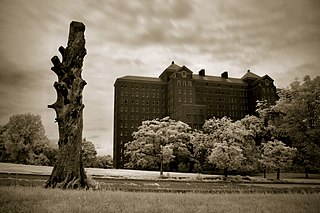
The Kings Park Psychiatric Center, known by Kings Park locals as "The Psych Center", is a former state-run psychiatric hospital located in Kings Park, New York. It operated from 1885 until 1996, when the State of New York closed the facility, releasing its few remaining patients or transferring them to the still-operational Pilgrim Psychiatric Center.
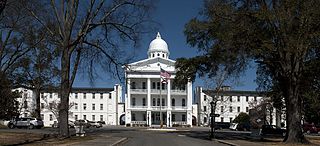
Bryce Hospital opened in 1861 in Tuscaloosa, Alabama, United States. It is Alabama's oldest and largest inpatient psychiatric facility. First known as the Alabama State Hospital for the Insane and later as the Alabama Insane Hospital, the building is considered an architectural model. The hospital currently houses 268 beds for acute care, treatment and rehabilitation of full-time (committed) patients. The Mary Starke Harper Geriatric Psychiatry Hospital, a separate facility on the same campus, provides an additional 100 beds for inpatient geriatric care. The main facility was added to the National Register of Historic Places in 1977.

Pilgrim Psychiatric Center, formerly known as Pilgrim State Hospital, is a state-run psychiatric hospital located in Brentwood, New York. Nine months after its official opening in 1931,the hospital's patient population was 2,018, as compared with more than 5,000 at the Georgia State Sanitarium in Milledgeville, Ga. At its peak in 1954, Pilgrim State Hospital could claim to be the largest mental hospital in the U.S., with 13,875 patients. Its size has never been exceeded by any other facility, though it is now far smaller than it once was.

Greystone Park Psychiatric Hospital referred to both the former psychiatric hospital and the historic building that it occupied in Morris Plains, New Jersey. Built in 1876, the facility was built to alleviate overcrowding at the state's only other "lunatic asylum" located in Trenton, New Jersey. Originally built to accommodate 350 people, the facility, having been expanded several times, reached a high of over 7700 patients resulting in unprecedented overcrowding conditions. In 2008, the facility was ordered to be closed as a result of deteriorating conditions and overcrowding. A new facility was built on the large Greystone campus nearby and bears the same name as the aging facility. Despite considerable public opposition and media attention, demolition of the main Kirkbride building began in April 2014 and was completed by October 2015.

Oregon State Hospital is a public psychiatric hospital in the U.S. state of Oregon, located in the state's capital city of Salem with a smaller satellite campus in Junction City opened in 2014. Founded in 1862 and constructed in the Kirkbride Plan design in 1883, it is the oldest operating psychiatric hospital in the state of Oregon, and one of the oldest continuously operated hospitals on the West Coast.

The Blockley Almshouse, later known as Philadelphia General Hospital, was a charity hospital and poorhouse located in West Philadelphia. It originally opened in 1732/33 in a different part of the city as the Philadelphia Almshouse. Philadelphia General Hospital closed in 1977.

Dixmont State Hospital was a hospital located northwest of Pittsburgh, Pennsylvania. Built in 1862, Dixmont was once a state-of-the-art institution known for its highly self-sufficient and park-like campus, but a decline in funding for state hospitals and changing philosophies in psychiatric care caused the hospital to be closed in 1984. After more than two decades of abandonment, it was finally demolished in 2006. The campus spanned a total of 407 acres (165 ha). Reed Hall is listed on the National Register of Historic Places.

Parkwood is a neighborhood located in the Far Northeast section of Philadelphia, Pennsylvania, United States. The neighborhood's boundaries include the Byberry East Industrial Park to the north and northwest, Poquessing Creek to the east, Knights Road to the southeast and Woodhaven Road to the southwest. The neighborhood was developed by Hyman Korman in the 1960-62 as a planned residential community. The predominant housing type is the brick row house. The Parkwood Shopping Center is a local shopping destination, while the Philadelphia Mills mall is a regional shopping destination on Knights Road to the east of Parkwood's residential area.
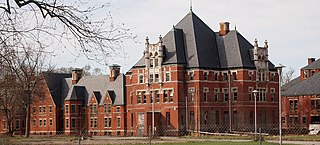
The Norwich State Hospital, originally established as Norwich State Hospital for the Insane and later shortened to Norwich Hospital, was a psychiatric hospital that is located in Preston and Norwich, Connecticut. It opened its doors in October 1904 and it remained operational until October 10, 1996. Throughout its years of operation, it housed geriatric patients, chemically dependent patients and, from 1931 to 1939, tubercular patients. The hospital, which sits on the banks of the Thames River, began with a single building on 100 acres (40 ha) of land and expanded to, at its peak, over thirty buildings and 900 acres (360 ha).
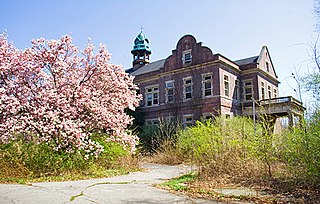
Pennhurst State School and Hospital, originally known as the Eastern Pennsylvania State Institution for the Feeble-Minded and Epileptic was an institution for mentally and physically disabled individuals of Southeastern Pennsylvania located in Spring City. After 79 years of controversy, it closed on December 9, 1987.

The Rosewood Center was an institution for people with developmental disabilities located on Rosewood Lane in Owings Mills, Maryland.

Norristown State Hospital, originally known as the State Lunatic Hospital at Norristown, is an active state-funded psychiatric hospital located outside the city of Philadelphia in suburban Norristown, Pennsylvania. It was originally designed between 1878 and 1880, by the local firm of Wilson Brothers & Company; of which, the original structure was set in a red brick Victorian High Gothic motif. It remains active for its originally clinical intention, and currently serving Bucks County, Chester County, Delaware County, Montgomery County and Philadelphia County, providing clinical services in General Psychiatry and Forensic Psychiatry. Additionally, there are various agencies that sublet state hospital buildings for a variety of psychiatric, residential and social services. These agencies currently make up the majority of services that are offered on the grounds of the hospital.

Medfield State Hospital, originally the Medfield Insane Asylum, is a historic former psychiatric hospital complex at 45 Hospital Road in Medfield, Massachusetts, United States. The asylum was established in 1892 as the state's first facility for dealing with chronic mental patients. The college-like campus was designed by William Pitt Wentworth and developed between 1896 and 1914. After an era dominated by asylums built using the Kirkbride Plan, Medfield Insane Asylum was the first asylum built using the new Cottage Plan layout, where instead of holding patients in cells, they would be integrated into a small community and work a specific job. It was formally renamed "Medfield State Hospital" in 1914.

Henryton State Hospital is a now-demolished hospital complex in Marriottsville, in southern Carroll County, Maryland, just across the Howard County line. The complex was located within Patapsco Valley State Park and along its southern end runs CSX's Old Main Line Subdivision and is very close to the Henryton Tunnel. The Henryton State Hospital center, or the Henryton Tuberculosis Sanatorium as it was called, was erected in 1922 by the Maryland Board of Mental Hygiene. It was established as a facility to treat African Americans suffering from tuberculosis. This was one of the first such facilities in Maryland erected to provide African Americans with the same level of treatment as white people. Other accounts state that this was more of containment Hospital rather than a treatment facility. They contend that Henryton was used more for the exile and quarantine of tuberculosis patients.

The North Princeton Developmental Center, formerly known as the New Jersey State Village for Epileptics, was a medical facility within Montgomery Township, Somerset County, New Jersey. The facility was home to a variety of mental health institutions throughout the years. In 2011, the former self-sustaining mental health village was slated for demolition to make space for a proposed county park. Demolition was completed in 2012 with plans to begin construction of the conceptual park in 2013. The facility garnered much notoriety over the past decades due to its "ghost town" appearance and mention in the popular book and periodical, "Weird N.J." Until its demolition, the former hospital was a popular place for "urban explorers" to explore, despite the buildings being unsafe (partially due to asbestos and lead paint contamination. Urban explorers were often met with resistance from law enforcement, as the site was prone to criminal activity, ranging from graffiti to arson. Prior to the demolition of the site, state and local governments have both made reasonable attempts to keep trespassers out, for example by sealing the entrances and windows of the property, though these methods proved to be relatively ineffective.

Danville State Hospital in Danville, Pennsylvania is a mental health facility operated by the Pennsylvania Department of Public Welfare. It was Pennsylvania's third public facility to house the mentally ill and disabled.
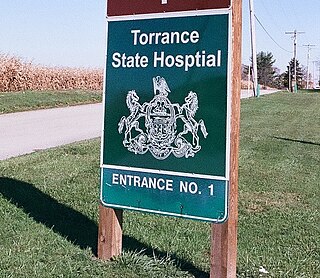
Torrance State Hospital is one of six State Hospitals in the Commonwealth of Pennsylvania.

Letchworth Village was a residential institution located in Rockland County, New York, in the hamlet of Thiells built for the physically and mentally disabled of all ages, from the newborn to the elderly. Opened in 1911, Letchworth Village at its peak consisted of over 130 buildings spread out over many acres of land. It was named for William Pryor Letchworth, who espoused reform in the treatment and care of the insane, epileptics, and poor children.

Kingsley Green is a mental health and learning disability site located in Hertfordshire, England, just southeast of the village of London Colney.





















